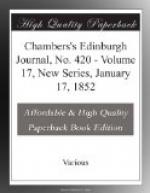It would be too much for the present sketch to describe the many invalids before whom we passed in our visits to the sick-chambers of the Sisters of Charity, though every single case would be a lesson to humanity. The homeless, the forsaken, the orphan, each had his or her own bitter history, previous to reposing within the sanctuary of that blessed retreat; each was attended by some of those benevolent beings, whose gentle steps and sweet sunny smiles brought peace to their hearts. None who are destitute are rejected at that gate of mercy. Whatever their faults may have been, whatever their frailties, if overtaken by want or sickness—if, deserted and trampled upon, they sink without any visible hand being stretched out to save them from despair and death—then do the Sisters of Charity interpose to succour and to save. To them it is sufficient that the sufferer requires their aid. There every medical assistance is promptly given; every comfort, and even luxury.
Most surprising it is to the common worldling to see these gentle beings thus living entirely for others, seeking no reward but that inspired by Christian promises and hopes. Nor is it mere drudgery and self-denial which constitute their great merit. When humanity calls from the midst of danger, whether in the shape of pestilence or of war, they are equally unfailing. It has been our lot to see a city taken by storm, the streets on fire and half-choked with ruins, and these ruins thickly strewed with the dead and dying. There, before the wild scene had been in the least




